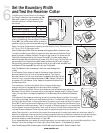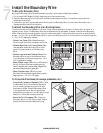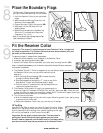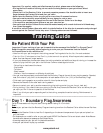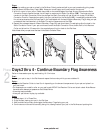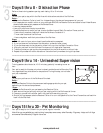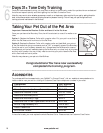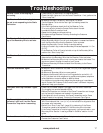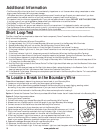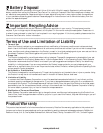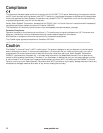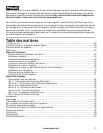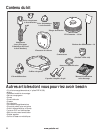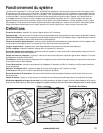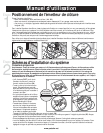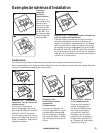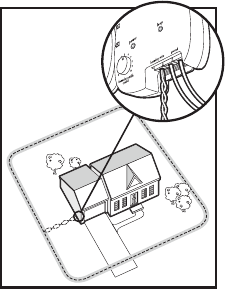
18 www.petsafe.net
Additional Information
• The Boundary Wire is buried so that it is not accidentally tripped over or cut. Use care when using a weed eater or when
digging near the Boundary Wire to prevent damage.
• The system should only be used with healthy pets who are over 6 months of age. Contact your veterinarian if you have
concerns about the medical condition of your pet (medication, pregnant, heart conditions, etc.).
• This system is not for vicious or aggressive pets. If your pet may pose a threat to others, DO NOT USE THIS SYSTEM.
If you are unsure if your pet is aggressive, please consult your veterinarian or a certifi ed trainer.
• The PetSafe
®
In-Ground Fence
™
is for residential use only.
• The Static Correction will get your pet’s attention, but will not cause harm. It is designed to startle, not to punish.
• Test the Receiver Collar at least once a month to verify it is functioning properly. Check that it activates at the Boundary
Wire. Battery life depends upon how often the Receiver Collar is activated.
__________________________________________________
Short Loop Test
The Short Loop Test is a simple test to determine if each component (Fence Transmitter, Receiver Collar and Boundary
Wire) is functioning properly.
1. Disconnect the Boundary Wire and Ground Wire.
2. Cut approximately 3 m (10 ft) of unused Boundary Wire and connect it to the Boundary Wire Terminals.
3. Spread the Boundary Wire out into a circle. Set the Boundary Control Switch to B.
4. Set the Boundary Width Control knob to 10 and the Static Correction Level to level 2 or above.
5. If the Loop Indicator Light is not lit, then your Fence Transmitter is not functioning properly. Contact the Customer
Care Centre.
6. If the Loop Indicator Light is lit, disconnect one end of the Boundary Wire from the Boundary Wire Terminal.
7. If the loop alarm does not sound, the Fence Transmitter needs to be replaced. Contact the Customer Care Centre.
8. If the loop alarm does sound, plug the Boundary Wire back into the Boundary Wire Terminal.
9. Hold the Receiver Collar next to the 3 m (10 ft) length of Boundary Wire. The Receiver Collar should beep about 0.3 m
(1 ft) away from the Boundary Wire.
10. Hold the Test Light contacts to the Contact Points. The Test Light should fl ash when you hold the Receiver Collar close
to the Boundary Wire.
11. If Receiver Collar does not beep and the Test Light does not fl ash, replace the battery in the Receiver Collar. If it still
does not beep and the Test Light does not fl ash, contact the Customer Care Centre.
12. If the Receiver Collar beeps, there may be a complete or partial break in the Boundary Wire. See the “To Locate a Break
in the Boundary Wire” section.
__________________________________________________
To Locate a Break in the Boundary Wire
Please follow these steps in determining where you have a break in your Boundary Wire:
1. Locate your original splice(s) and verify they have a good, solid connection.
2. Check your yard to determine any possible damage to the Boundary Wire (e.g. recent digging, aerating, rodent
burrowing, or any other noticeable disturbance in your yard next to the Boundary Wire).
If you still cannot fi nd the break in the Boundary Wire, there are two options for locating it:
Option 1: Contact the Customer Care Centre to purchase a Wire Break Locator that will locate the break in the Boundary Wire.
Option 2: Follow the procedure below:
1. Unplug the Fence Transmitter.
2. Connect both ends of your twisted Boundary Wire to one Boundary Wire Terminal.
3. Measure and cut a Test Wire which is half the length of your total Boundary Wire footage.
4. Connect one end of the Test Wire to the other Boundary Wire Terminal.
5. Locate the halfway point of your boundary and cut the Boundary Wire.
6. Splice the other end of the Test Wire to either side of your Boundary Wire where you cut it in half.
7. Plug in the Fence Transmitter and check the Loop Indicator Light. If the Loop Indicator
Light is on you can assume the break is in the other half of the Boundary Wire.
8. If the Loop Indicator Light did not come on, you may assume there is a break in this
portion of the Boundary Wire. However, there is a small chance of having more than one
break in your system. Be sure to check both halves of your entire loop.
9. Replace the damaged Boundary Wire with new Boundary Wire.
10. Reconnect the Boundary Wire to the Fence Transmitter.
Ground
Wire
Te s t
Wire
Boundary
Wires
11. Check the Loop Indicator Light. If the Loop Indicator Light is on, test the system with the Receiver Collar.



